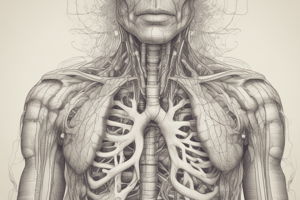Podcast
Questions and Answers
What is the primary function of the respiratory system?
What is the primary function of the respiratory system?
- Facilitating gas exchange (correct)
- Producing hormones
- Regulating body temperature
- Circulating blood throughout the body
Which of the following structures is part of the upper respiratory tract?
Which of the following structures is part of the upper respiratory tract?
- Nasal Cavity (correct)
- Lungs
- Alveoli
- Trachea
What happens during inhalation?
What happens during inhalation?
- Carbon dioxide is absorbed
- The chest cavity contracts
- Air is expelled from the lungs
- The diaphragm contracts and moves down (correct)
Which type of respiration is demonstrated by earthworms?
Which type of respiration is demonstrated by earthworms?
How many times does a normal person breathe when at rest?
How many times does a normal person breathe when at rest?
What is the role of the epiglottis in the respiratory system?
What is the role of the epiglottis in the respiratory system?
Which structure is primarily responsible for gas exchange within the lungs?
Which structure is primarily responsible for gas exchange within the lungs?
Which organisms primarily use gills for gas exchange?
Which organisms primarily use gills for gas exchange?
What bacteria is responsible for causing tuberculosis?
What bacteria is responsible for causing tuberculosis?
Which symptom is NOT associated with the common cold?
Which symptom is NOT associated with the common cold?
Which condition is characterized by persistent cough and can lead to long-term effects?
Which condition is characterized by persistent cough and can lead to long-term effects?
What is a common cause of bronchitis aside from viral infections?
What is a common cause of bronchitis aside from viral infections?
What symptom suggests a severe progression of tuberculosis?
What symptom suggests a severe progression of tuberculosis?
What defines the phenotype of an organism?
What defines the phenotype of an organism?
Incomplete dominance results in which type of phenotype formation?
Incomplete dominance results in which type of phenotype formation?
Which statement accurately describes codominance?
Which statement accurately describes codominance?
Which of the following best describes multiple alleles?
Which of the following best describes multiple alleles?
What type of inheritance pattern does the ABO blood typing system illustrate?
What type of inheritance pattern does the ABO blood typing system illustrate?
The Rh factor in blood typing is primarily responsible for determining what?
The Rh factor in blood typing is primarily responsible for determining what?
Which of the following statements is NOT a characteristic of the P1 generation?
Which of the following statements is NOT a characteristic of the P1 generation?
What is the term used to describe the clumping of particles in blood due to antigen-antibody interactions?
What is the term used to describe the clumping of particles in blood due to antigen-antibody interactions?
What is the blood genotype for type O?
What is the blood genotype for type O?
Which of the following traits is categorized as X-linked?
Which of the following traits is categorized as X-linked?
What characterizes a sex-limited trait?
What characterizes a sex-limited trait?
Who first developed a model of the double-helix structure of DNA?
Who first developed a model of the double-helix structure of DNA?
Which component is NOT one of the building blocks of DNA?
Which component is NOT one of the building blocks of DNA?
What defines sex-influenced traits?
What defines sex-influenced traits?
What term did Johann Friedrich Miescher coin while studying white blood cells?
What term did Johann Friedrich Miescher coin while studying white blood cells?
Which of the following is NOT an example of a sex-limited trait?
Which of the following is NOT an example of a sex-limited trait?
Which nitrogenous bases are classified as purines?
Which nitrogenous bases are classified as purines?
What type of chromosome pair comprises sex chromosomes?
What type of chromosome pair comprises sex chromosomes?
What is the total number of chromosomes in a child with Down Syndrome?
What is the total number of chromosomes in a child with Down Syndrome?
What is the role of hydrogen bonds in the structure of DNA?
What is the role of hydrogen bonds in the structure of DNA?
How many sets of chromosomes does a diploid organism have?
How many sets of chromosomes does a diploid organism have?
What does a karyotype show?
What does a karyotype show?
What can cause physical and intellectual anomalies in a child?
What can cause physical and intellectual anomalies in a child?
What is the total chromosome count in Turner Syndrome?
What is the total chromosome count in Turner Syndrome?
Flashcards are hidden until you start studying
Study Notes
The Respiratory System
- Breathing involves gas exchange essential for respiration: O2 + C6H12O6 → CO2 + H2O + ATP.
- Upper Respiratory Tract includes the nose, nasal cavity, pharynx, larynx, and epiglottis.
- Two forms of breathing: inhalation brings in O2, while exhalation releases CO2.
- Lower Respiratory Tract encompasses the trachea, bronchi, bronchioles, alveoli, and diaphragm.
Types of Respiration
- Cutaneous Respiration: Gas exchange through the skin, typical in earthworms.
- Gills: Adapted for underwater gas exchange found in fish.
- Tracheal System: Notable in insects with spiracles for gas exchange.
Genetics and Inheritance
- Phenotype reflects an organism's observable traits; influenced by genotype and environment.
- Incomplete Dominance: Heterozygous individuals show an intermediate phenotype.
- Codominance: Both alleles appear equally in a heterozygote.
- Multiple Alleles: More than two allele forms for a single gene (e.g., ABO blood type).
Blood Typing
- ABO blood types stem from antigens on RBC surfaces.
- Rh factor determines blood positivity or negativity; observed in Rhesus monkeys.
- Universal donor type is O, while AB is the universal recipient.
Common Respiratory Diseases
- Common Cold: Caused by rhinoviruses, symptoms include sneezing and congestion.
- Tuberculosis: 9th leading cause of death; caused by Mycobacterium tuberculosis, characterized by bad cough and weight loss.
- Bronchitis: Inflammation of bronchial tubes, often caused by viral infections or pollutants.
Basic Genetics Concepts
- DNA: Discovered in WBCs by Johann Friedrich Miescher; termed "nuclein."
- Nitrogenous Bases: Consist of adenine, thymine, cytosine, and guanine; paired A-T and C-G.
- Chromosomes: Humans have 23 pairs (46 total), including sex chromosomes (23rd pair).
Types of Genetic Traits
- X-Linked Traits: Inherited through X or Y chromosomes (e.g., color blindness).
- Sex-Limited Traits: Features observable only in one sex (e.g., lactation).
- Sex-Influenced Traits: Autosomal traits that express differently in sexes (e.g., baldness).
Chromosomal Abnormalities
- Down Syndrome (Trisomy 21): Extra chromosome resulting in 47 total.
- Turner Syndrome: Missing sex chromosome, resulting in 45 total chromosomes; leads to underdeveloped female reproductive systems.
Karyotype and Chromosomes
- Karyotype is a complete set of an individual’s chromosomes.
- Each chromosome contains chromatids joined at the centromere.
Studying That Suits You
Use AI to generate personalized quizzes and flashcards to suit your learning preferences.




